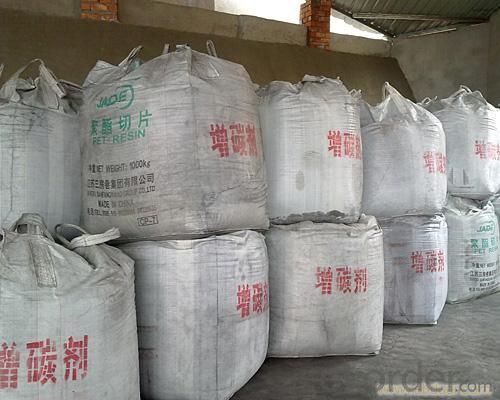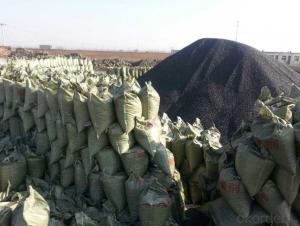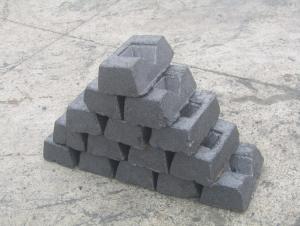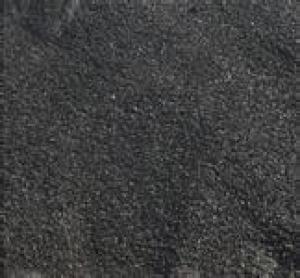FC94 Carbon Additive/CNBM China Carbon Additive Product
- Loading Port:
- Tianjin
- Payment Terms:
- TT OR LC
- Min Order Qty:
- 0 m.t.
- Supply Capability:
- 100000 m.t./month
OKorder Service Pledge
OKorder Financial Service
You Might Also Like
Packaging & Delivery
| Packaging Detail: | 25kgs/50kgs/1ton per bag or as buyer's request |
| Delivery Detail: | Within 20 days after receiving corect L/C |
Specifications
Calcined Anthracite
Fixed carbon: 90%-95%
S: 0.5% max
Size: 0-3. 3-5.3-15 or as request
Feature
All of our goods are made in the best quality of world famous Tianjin. All of our products are with High carbon, Low ash, low sulphur, Low Moisture.
Application
The Calcined Anthracite Coal/Gas Calcined Anthracite Coal/Carbon Raiser is mainly used in steelmaking in electrical stove, screening water, shipbuilding sandblast to remove rust. It can reduce the cost of steelmaking effectively by replacing the traditional petroleum coke of carburant.Also can improve the Carbon content in steel-melting and Ductile iron foundry.
Specifications
Calcined Anthracite
Fixed carbon: 90%-95%
S: 0.5% max
Size: 0-3. 3-5.3-15 or as request
PARAMETER UNIT GUARANTEE VALUE | |||||
F.C.% | 95MIN | 94MIN | 93MIN | 92MIN | 90MIN |
ASH % | 4MAX | 5MAX | 6MAX | 7MAX | 8MAX |
V.M.% | 1 MAX | 1MAX | 1.5MAX | 1.5MAX | 1.5MAX |
SULFUR % | 0.5MAX | 0.5MAX | 0.5MAX | 0.5MAX | 0.5MAX |
MOISTURE % | 0.5MAX | 0.5MAX | 0.5MAX | 0.5MAX | 0.5MAX |
Size can be adjusted based on buyer's request.
Picture


- Q: What should we do to reduce carbon emissions in our lives?
- The use of public transport, of course, is best to walk long distances, as far as possible the use of roads or railways, aircraft carbon emissions, the largest use of disinfection chopsticks, do not use disposable tableware, handkerchiefs do not use napkins
- Q: How do fossil fuels release carbon into the atmosphere?
- Fossil fuels release carbon into the atmosphere through a process called combustion. When fossil fuels such as coal, oil, and natural gas are burned for energy, the carbon that was trapped underground for millions of years is released as carbon dioxide (CO2) gas. During combustion, the carbon and hydrogen atoms in fossil fuels react with oxygen in the air to produce CO2, water vapor (H2O), and heat. The released CO2 is then emitted into the atmosphere as a greenhouse gas. The burning of fossil fuels in various sectors such as transportation, electricity generation, and industrial processes is a significant contributor to the increase in atmospheric CO2 levels. The continuous extraction and burning of these fuels at a rapid rate have resulted in a substantial increase in the concentration of CO2 in the Earth's atmosphere over the past century. This increase in atmospheric CO2 is a major cause of climate change because CO2 acts as a heat-trapping gas, which leads to the greenhouse effect. The greenhouse effect is the process by which the Earth's atmosphere retains the heat radiated from the surface, causing a rise in global temperatures. The release of carbon from fossil fuels into the atmosphere is therefore a major concern due to its role in climate change and the subsequent environmental and societal impacts. To mitigate these effects, there is a growing global effort to shift towards renewable and cleaner sources of energy, reduce fossil fuel consumption, and implement sustainable practices.
- Q: How are carbon nanomaterials used in electronics?
- Due to their unique properties and versatility, carbon nanomaterials find widespread use in the field of electronics. A common application of these materials is in the creation of highly efficient and flexible conductive materials. Both carbon nanotubes (CNTs) and graphene, which fall under the category of carbon nanomaterials, possess remarkable electrical conductivity, making them ideal for the production of conductive components in electronic devices. CNTs are cylindrical structures comprised of rolled-up graphene sheets. They can be utilized as interconnects in integrated circuits, enhancing performance by reducing resistance and promoting heat dissipation. Furthermore, CNTs can be employed in transistors, facilitating faster and more efficient switching due to their high electron mobility. Their small size and flexibility render them suitable for the construction of transparent conductive films used in touchscreens and flexible electronics. On the other hand, graphene is a two-dimensional sheet composed of carbon atoms arranged in a hexagonal lattice. It is renowned for its exceptional electrical conductivity, high electron mobility, and excellent thermal conductivity. Materials based on graphene can function as electrodes in batteries and supercapacitors, thereby enhancing their energy storage capacity. Additionally, graphene transistors possess the potential to replace traditional silicon-based transistors, resulting in faster and more energy-efficient electronic devices. Furthermore, carbon nanomaterials, particularly CNTs, exhibit promise in the realm of nanoelectromechanical systems (NEMS). NEMS devices are exceedingly small and sensitive, enabling applications such as sensors, actuators, and resonators. CNT-based NEMS devices have displayed exceptional sensitivity and responsiveness, making them suitable for various sensing applications, including pressure, gas, and biological sensing. In conclusion, carbon nanomaterials play a vital role in the field of electronics by offering highly conductive and versatile materials for different components and applications. Their unique properties, such as excellent electrical and thermal conductivity, make them ideal for the production of faster, more efficient, and flexible electronic devices. As research and development in this field continue to advance, carbon nanomaterials are poised to revolutionize the electronics industry.
- Q: How does carbon affect water quality?
- Carbon can have both positive and negative effects on water quality. On one hand, carbon is a natural part of the carbon cycle and plays a crucial role in maintaining the balance of aquatic ecosystems. Carbon can act as a nutrient for aquatic plants, promoting their growth and providing food and habitat for other organisms within the food chain. However, excessive amounts of carbon in water can lead to negative impacts on water quality. One way this occurs is through an increase in dissolved organic carbon (DOC). Elevated levels of DOC can result from the decomposition of organic matter, such as dead plants and animals, and the leaching of organic compounds from soil. These organic compounds can have negative effects on water quality by reducing the amount of dissolved oxygen available for aquatic organisms, which can lead to the suffocation of fish and other aquatic life. Additionally, high levels of carbon can contribute to the process of eutrophication. Eutrophication occurs when there is an excess of nutrients, including carbon, in water bodies, leading to an overgrowth of algae and other aquatic plants. This excessive growth can result in the depletion of oxygen levels in the water as the plants decompose, causing harm to fish and other organisms that rely on oxygen for survival. Furthermore, carbon can also interact with other pollutants present in water, such as heavy metals and pesticides, which can become more toxic and bioavailable when combined with carbon. This can have detrimental effects on aquatic organisms and disrupt the overall balance of the ecosystem. Overall, while carbon is essential for the functioning of aquatic ecosystems, excessive amounts can negatively impact water quality by reducing oxygen levels, promoting eutrophication, and enhancing the toxicity of other pollutants. Therefore, it is crucial to monitor and manage carbon levels in water bodies to ensure the maintenance of a healthy and balanced aquatic ecosystem.
- Q: How is carbon used in the production of fuel cells?
- Carbon is used in the production of fuel cells in several ways. One of the main uses of carbon in fuel cells is in the construction of the electrodes. Fuel cells consist of an anode and a cathode, and carbon-based materials such as graphite or carbon paper are commonly used to make these electrodes. These carbon-based materials provide a conductive surface for the electrochemical reactions that occur within the fuel cell. Additionally, carbon is used as a catalyst in fuel cells. Catalysts are substances that speed up chemical reactions without being consumed in the process. In fuel cells, carbon-based catalysts such as platinum or palladium are commonly used to facilitate the reactions that produce electricity. These catalysts allow for more efficient conversion of fuel into electrical energy. Furthermore, carbon is used in the form of carbon nanotubes in the production of fuel cells. Carbon nanotubes possess unique properties such as high surface area and excellent electrical conductivity, which make them ideal for enhancing the performance of fuel cells. They can be used to improve the efficiency of fuel cell reactions by providing a larger surface area for the reactions to take place on. Overall, carbon plays a crucial role in the production of fuel cells by providing the necessary materials for the construction of electrodes, serving as catalysts for the electrochemical reactions, and enhancing the performance of fuel cells through the use of carbon nanotubes.
- Q: What is a carbon free martensite?
- The definition of martensite of Fe based alloy (solid steel and other iron-based alloy) and non ferrous metals and alloys, is guetche variant diffusion free phase transition product of martensitic transformation. It is a product of Fe based alloy, phase transformation of undercooled austenite occurs without diffusion were guetche formation of martensite variant body transformation.
- Q: Why is the longer the carbon chain, the better the hydrophobic properties?
- Alkyl chains, low in polarity, insoluble in water...... Release53 (TA station) of all alkanes alkane chain containing even chemical bonds are sigma bond, charge distribution in the molecule is not very uniform, the movement process can produce instantaneous dipole moment, but the total dipole moment is zero, non polar molecules. According to the similarity principle of compatibility, alkane in general can only be dissolved in carbon tetrachloride, like hydrocarbons and other non polar solvent, so the more you long alkane chain, as hydrophobic groups, then you must material hydrophobicity and better advice and look at textbooks still need some basic theory of organic.
- Q: What are the impacts of carbon emissions on ecosystems?
- Carbon emissions have significant impacts on ecosystems. Increased levels of carbon dioxide in the atmosphere contribute to global warming, leading to changes in temperature and climate patterns. This can disrupt ecosystems by altering the timing of natural events, such as flower blooming or bird migration, and affecting the availability of resources like water and food. Additionally, carbon emissions can lead to ocean acidification, which harms marine life and coral reefs. Overall, carbon emissions pose a threat to the balance and functioning of ecosystems, ultimately impacting biodiversity and the health of our planet.
- Q: How does deforestation contribute to carbon emissions?
- Deforestation contributes to carbon emissions by releasing large amounts of stored carbon dioxide (CO2) into the atmosphere. Trees act as carbon sinks, absorbing CO2 from the air during photosynthesis and storing it in their biomass. When forests are cleared or burned, this stored CO2 is released back into the atmosphere, adding to greenhouse gas levels and contributing to climate change.
- Q: How are carbon-based polymers synthesized?
- Polymerization is the process by which carbon-based polymers are created. It entails the chemical reaction of small molecules called monomers to form long chains of repeating units, known as polymers. Organic polymers, or carbon-based polymers, are composed of carbon atoms bonded together in a backbone structure. There are several methods for synthesizing carbon-based polymers, with addition polymerization being the most common. Addition polymerization occurs when monomers containing unsaturated carbon-carbon double bonds, like ethylene or propylene, undergo a reaction initiated by a catalyst. This catalyst can be heat, light, or a chemical initiator, and it causes the monomers to join together, forming a polymer chain. Another method for synthesizing carbon-based polymers is condensation polymerization. In this process, two different types of monomers react with each other, resulting in the elimination of a small molecule, such as water or alcohol. The remaining monomers then continue to react, forming a polymer chain. Polyesters and polyamides are examples of polymers synthesized through condensation polymerization. In addition to these methods, other techniques like ring-opening polymerization and step-growth polymerization are also used to synthesize carbon-based polymers. Ring-opening polymerization involves the opening of cyclic structures to form linear polymer chains, while step-growth polymerization involves the reaction of two or more monomers with reactive end groups. In conclusion, the synthesis of carbon-based polymers involves combining monomers through various chemical reactions to form long chains of repeating units. These polymers find wide applications in industries such as plastics, textiles, and electronics, thanks to their desirable properties such as strength, flexibility, and thermal stability.
Send your message to us
FC94 Carbon Additive/CNBM China Carbon Additive Product
- Loading Port:
- Tianjin
- Payment Terms:
- TT OR LC
- Min Order Qty:
- 0 m.t.
- Supply Capability:
- 100000 m.t./month
OKorder Service Pledge
OKorder Financial Service
Similar products
Hot products
Hot Searches






















